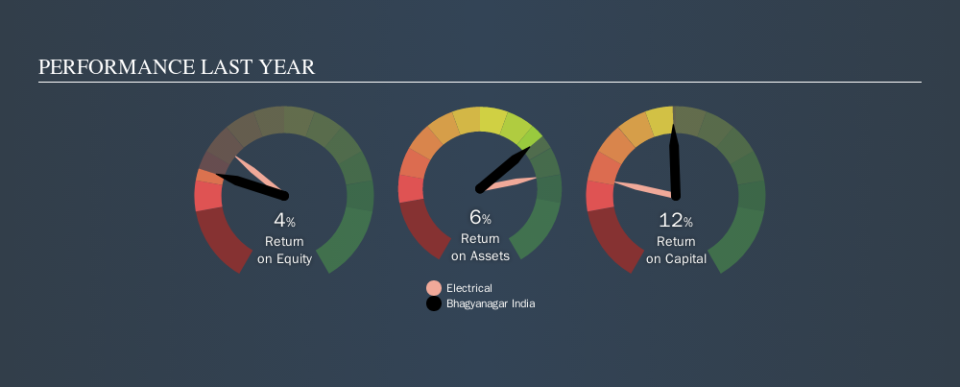How Good Is Bhagyanagar India Limited (NSE:BHAGYANGR) At Creating Shareholder Value?

Today we'll look at Bhagyanagar India Limited (NSE:BHAGYANGR) and reflect on its potential as an investment. Specifically, we're going to calculate its Return On Capital Employed (ROCE), in the hopes of getting some insight into the business.
First, we'll go over how we calculate ROCE. Next, we'll compare it to others in its industry. And finally, we'll look at how its current liabilities are impacting its ROCE.
Return On Capital Employed (ROCE): What is it?
ROCE is a metric for evaluating how much pre-tax income (in percentage terms) a company earns on the capital invested in its business. All else being equal, a better business will have a higher ROCE. In brief, it is a useful tool, but it is not without drawbacks. Renowned investment researcher Michael Mauboussin has suggested that a high ROCE can indicate that 'one dollar invested in the company generates value of more than one dollar'.
So, How Do We Calculate ROCE?
Analysts use this formula to calculate return on capital employed:
Return on Capital Employed = Earnings Before Interest and Tax (EBIT) ÷ (Total Assets - Current Liabilities)
Or for Bhagyanagar India:
0.12 = ₹155m ÷ (₹2.4b - ₹1.1b) (Based on the trailing twelve months to June 2019.)
Therefore, Bhagyanagar India has an ROCE of 12%.
View our latest analysis for Bhagyanagar India
Is Bhagyanagar India's ROCE Good?
ROCE can be useful when making comparisons, such as between similar companies. We can see Bhagyanagar India's ROCE is around the 13% average reported by the Electrical industry. Separate from how Bhagyanagar India stacks up against its industry, its ROCE in absolute terms is mediocre; relative to the returns on government bonds. Investors may wish to consider higher-performing investments.
We can see that, Bhagyanagar India currently has an ROCE of 12% compared to its ROCE 3 years ago, which was 2.7%. This makes us think about whether the company has been reinvesting shrewdly. The image below shows how Bhagyanagar India's ROCE compares to its industry, and you can click it to see more detail on its past growth.
It is important to remember that ROCE shows past performance, and is not necessarily predictive. Companies in cyclical industries can be difficult to understand using ROCE, as returns typically look high during boom times, and low during busts. This is because ROCE only looks at one year, instead of considering returns across a whole cycle. You can check if Bhagyanagar India has cyclical profits by looking at this free graph of past earnings, revenue and cash flow.
What Are Current Liabilities, And How Do They Affect Bhagyanagar India's ROCE?
Short term (or current) liabilities, are things like supplier invoices, overdrafts, or tax bills that need to be paid within 12 months. Due to the way ROCE is calculated, a high level of current liabilities makes a company look as though it has less capital employed, and thus can (sometimes unfairly) boost the ROCE. To check the impact of this, we calculate if a company has high current liabilities relative to its total assets.
Bhagyanagar India has total assets of ₹2.4b and current liabilities of ₹1.1b. Therefore its current liabilities are equivalent to approximately 46% of its total assets. Bhagyanagar India's middling level of current liabilities have the effect of boosting its ROCE a bit.
Our Take On Bhagyanagar India's ROCE
With this level of liabilities and a mediocre ROCE, there are potentially better investments out there. Of course, you might also be able to find a better stock than Bhagyanagar India. So you may wish to see this free collection of other companies that have grown earnings strongly.
If you like to buy stocks alongside management, then you might just love this free list of companies. (Hint: insiders have been buying them).
We aim to bring you long-term focused research analysis driven by fundamental data. Note that our analysis may not factor in the latest price-sensitive company announcements or qualitative material.
If you spot an error that warrants correction, please contact the editor at editorial-team@simplywallst.com. This article by Simply Wall St is general in nature. It does not constitute a recommendation to buy or sell any stock, and does not take account of your objectives, or your financial situation. Simply Wall St has no position in the stocks mentioned. Thank you for reading.


